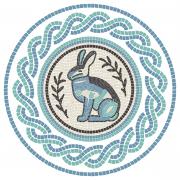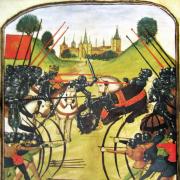Martin Maudsley explores the month of May, through the changing patterns of nature to its celebrations, poetry and folklore
In the Celtic calendar, with its underlying duality of a dark half and a light half of the year, Beltane marks the end of winter and the beginning of summer. Its liminality holds special significance: the cusp of the seasons, the transition from April into May, and the twilight period between day and night. It’s a time when annual archetypal rivalries are played out: in one Celtic legend two opposing dragons fight for seasonal supremacy. Similarly, in Welsh mythology, two immortal heroes – Gwythyr ap Greidawl and Gwyn ap Nudd – battle each other on the eve of Calan Mai (May 1).
The word Beltane (sometimes spelled ‘Beltaine’) is generally thought to mean ‘bright fire’. Bonfires are a focal point for all the Celtic celebrations at the opening of each season, but the flames hold special significance at Beltane. Fires imitate the heat of the sun, and the sympathetic magic instilled in Beltane rituals encourage its warmth to rise through the season, as summer is kindled. In pastoral societies this was the time of year for grazing animals to be returned to green pastures. The flames, and smoke, of Beltane fires also played a role in both purifying and protecting precious livestock. The ashes from these outdoor bonfires held similarly protective powers when brought back to household hearths.

Dancing around a Beltane fire – clockwise, with the sun – invites blessings of fortune and fertility for the year ahead. Sometimes a lord and lady of May were chosen to leap through the flames of a fire, as an echo of symbolic ‘sacrifice’. In some parts of Britain and Ireland the ritual flames have been nurtured over the years, and many more have been rekindled in modern-day seasonal celebrations, such as the renowned Beltane Fire Society in Edinburgh. For many of us, the bright fires of Beltane continue to bring a sense of ‘wildness’ into everyday lives, at a time when the natural world itself is rearing up in rampant growth and the Green Man is arising again.

Bringing in the May
The woodland bower is white with flower and green is every tree.
Just as Beltane fires light up our lives on the eve of May, so bringing nature’s greenery and flowers into our homes on May Day symbolises and celebrates the renewal of life. Early in the morning is the traditional time to go into the woods and gather branches and blossoms from nature’s refurnished bounty, then place them around our houses. It’s an outward expression of an auspicious moment in the seasonal cycle, marking the start of the brightest and warmest quarter of the year: from May Day until Lammas (August 1). It’s also a tangible method of re-engagement with nature after the dark days of winter. A posy of bright flowers on the table and green boughs around the doorway allows nature back into our homes, just as we feel inspired to step out into the wild world once more.
Hawthorn, also known as the May tree, begins to blossom at this time of year, and in the Old Calendar its flowering would have more fully coincided with May Day festivities. It is a key cultural component of this month’s many merry traditions, holding associations of frothing fertility and mischievous fairies. The rhyme ‘here we go gathering nuts in May’ originally derives from ‘knots’ of May – ie sprigs of hawthorn blossom. In Ireland it is often called whitethorn due to its creamy white flowers, and H.E. Bates poetically referred to the blossom as ‘the risen cream of all the milkiness of May-time’.
According to the folklore, May is the only time of year when it is acceptable to bring hawthorn into the house; otherwise it’s associated with death and ill fortune. Sycamore, gorse, hazel, rowan and birch are also widely used for May-time greenery, reflecting local habitats and cultural traditions. Another seasonal splash of colour is added by the bright yellow of marsh marigolds at this time of year, as indicated by their folk names – May flower and May blobs.

May Day, May Day
I like to rise when the sun she rises, early in the morning.
Greeting the rising sun early on May Morning is a long-standing and enduring magical moment in the cycle of the seasons – heralding the start of the light half of the year. Seeing the first rays of golden light breaking the dark horizon, just as the first blackbird sings in the valley below, is well worth getting up early for. As with many modern revivals of seasonal celebrations, these sunrise gatherings are often accompanied by local Morris teams – dancing on a hilltop (whatever the weather), then rolling down to the pub to drink in the atmosphere and sing May Day carols. At Cerne Abbas, in Dorset, the daybreak dancing takes place on Giant Hill, with the hulky chalk figure himself given a generous libation of ale from the local brewery.
In Cornwall, two well-known annual events celebrate May-time fertility through ritual folk dances: the ’Obby ’Oss in Padstow and Helston Flora Day, which are both preceded by decorating the towns in boughs of green and bowers of flowers. Not far away in Somerset, Minehead also has its own hobby horse, which rides out on May Day. In other places, flowery garlands are proudly paraded through the village, such as Abbotsbury Garland Day in Dorset, which takes place around Old May Day (13th May). The flowery bowers were originally offered as blessings to villagers’ households (in exchange for generous giving) and then taken down to the sea for a blessing on the opening of the fisheries. Such thriving May Day celebrations, and many others in all their vibrant variety, are still valued, not only as seasonal markers, but in uniting the whole local community again outdoors.
Where are the maidens that here now should sing?
For summer is a-come unto day,
They are in the meadows the flowers gathering,
In the merry morning of May.
It’s likely that maypoles originated as green boughs brought in from the woods, perhaps as ancient symbols of the World Tree (traditionally an ash) that holds the universe together in Norse mythology. They have become a popular focal point of many May Day celebrations, with coloured ribbons and interweaving style of dancing adopted in the nineteenth century. May Day is one of the main outings of the year for morris dancing sides, re-engaging with an older, wilder side of May Day festivities. Similarly, mummers’ plays that are performed at this time of year often depict rebellious spirits of the wildwood, notably Robin Hood, whose marriage to Maid Marian also embodies the fertility of the season.
The May tradition of flaunting flowers and foliage has become transposed into an archetypal anthropomorphic form: the Green Man. His face – usually a striking composite of human and vegetative features – looms large in medieval imagery, including (ironically, perhaps) many Christian churches. Jack-in-the-Green, a walking, dancing representation of the Green Man, is most commonly seen in cities and towns; perhaps due to its association with chimney sweeps, who took the opportunity to raise money at a time when their work was dying down. In recent times, Jack-in-the-Greens have been enthusiastically revived in many places, including London, Bristol and Rochester, bringing nature based revelry into urban locations where many people live and work. Alongside morris dancers and mummers’ plays, they incorporate and reinterpret the Beltane theme of ushering in summer, as Old Man Winter is driven away by the growing powers of the Green Man.
The Darling Buds of May
As well as ‘bringing in the May’, there’s both inspiration and opportunity for us to go outside to sense and savour the floweriness of May. The Romans celebrated the five-day festival of Floralia between April 28 and May 2, in honour of the fertility goddess Flora, who was venerated as the patron and protector of flowers. The month itself is named after Maia, a closely related Greek goddess of renewal. Beltane and May Day festivals have long been associated with flamboyant expressions of passion and fertility, in both natural and human worlds. Love is in the air, or at least lust, as this month is infamous for illicit liaisons:
Married in May and churched in green,
Both bride and groom won’t long be seen.
Sex is also bursting out on the branches. After the green mist of April, a white flowery mantle is draped across woodlands and hedges in May, offering the opportunity to stop and enjoy the magical moment of spring flourishing into summer. Each year a tide of blossom stretches out from early April to late May on blackthorn, plum, damson, cherry, hawthorn, apple and elder trees (plus non-fruiting species such as rowan and hazel), gracing the landscape with pastel petals and heavenly scents. Our long love affair with blossom is highlighted by English being one of the few languages with its own specific word for ‘treeflowers’ and in recent years the Japanese tradition of ‘blossom-bathing’ has caught our imagination at this time of year. Frothing cow parsley – also known as lady’s lace, fairy lace or Queen Anne’s lace – adds its own performance to this festival of floweriness. In natural synchrony, the symphony of early morning birdsong reaches its climax, as celebrated by International Dawn Chorus Day, held on the first Sunday of May. Time to stop and take it all in, before we get whisked away…

Away with the Fairies
Bluebells form a swelling sea of blue under the emerging leaf canopy in May; especially intense within luminous, lime-green beechwoods. Their sight and smell are often dreamlike and otherworldly, and bluebells have long been associated with the fairies. In the tale of Thomas the Rhymer, his encounter with the Fairy Queen is precipitated by the presence of bluebells. It is said they ‘ring’ to call the Little People together for their revels in the woods, but for humans to hear that sound spells death or abduction into Faerie – not always a pleasant place for mortals. A garland of bluebells can compel the wearer to speak the truth, echoing the eventual fate of Thomas.
Fairies are believed to choose lone hawthorn trees as focal points for their May Eve revelries and as such are considered sacrosanct. In Ireland, in particular, there are many dark tales detailing the gruesome comeuppances of those who dare to interfere with a fairy bush. By contrast, offerings of food and drink left under their blossoming branches invite a blessing from the Little People. Thorns growing beside sacred wells are, to this day, decorated with colourful ribbons and rags, as a propitious ritual. In other folklore, if you prick a finger on a thorn, you’ll fall into an enchanted asleep – the Icelandic word for hawthorn is ‘sleep-thorn’ and the spindle that pricked Sleeping Beauty in the fairy tale was made from hawthorn wood. Conversely, branches of hawthorn brought into the home at this time of year can also act as protection against being taken away by the fairies, especially in the case of ‘changelings’ (see August).
Both bluebells and hawthorn portend that the opening of May is a ripe time for encounters with the Others, including the Fairy Queen herself – as portrayed in A Midsummers Night’s Dream (which, despite the title, takes place on May Eve). Thomas the Rhymer is unusual in wanting to re-enter Faerie, where few would dare to go, and even fewer return. In the Ballad of Tam Lin, a distinctly darker Scottish fairy tale, the central character is only able to wrest himself free from the powerful enchantments of the Fairy Queen through the determination of a young woman who truly loves him. In Welsh legend, there is a fairy island on Llyn Cwm Llwch, which mortals may visit once a year on May Day. But removing anything is strictly forbidden – one man who broke the taboo by taking an apple, ending up losing his mind.

The Milkiness of May
Awake, ye pretty maids, awake, refreshed from drowsy dream,
And haste unto dairy house to fetch a dish of cream.
The Anglo-Saxon name for May was Thrimilce, meaning the ‘month of three milkings’, reflecting the prolific milk production once grazing animals were returned to summer pastures with its lush spring growth.
Similarly, in the Anglo-Saxon lunar calendar, the name for a full moon in May is Milk Moon. New season milk was once so precious that milk-snatching witches and fairies were greatly feared; particularly on May Day eve, which was formerly the date of Mischief Night before it switched to Halloween. May-flowering plants, namely hawthorn, rowan and marsh marigold, were commonly used deterrents against supernatural dairy raids.
Throughout medieval times, May was also widely celebrated as the time of year when fresh dairy produce was welcomed back by consumers and customers. Milk maids literally made a song and a dance out of it, and were often accompanied by Jack-inthe-Greens (see above). Merry milk maids, along with ancient fertility goddesses, were perhaps the precursors of more modern May Queens – the feminine figureheads that often grace local May Day celebrations, wearing milk white dresses and flowery crowns.
Flavour of the Month: May wine
By Matthew Pennington and The Ethicurean
Plants encountered as children can sometimes help identify those we might want to use later in adulthood. The bedstraw family contains a playful plant that you might well remember, which devilishly clings to clothes like Velcro. Sticky Willy, aka cleavers or goosegrass, is closely related to the vital ingredient in this recipe: sweet woodruff. This lower-lying and scented species is found in the woods. It has six to nine smooth, pointed green leaves extending from the square stem in whorls, with four-petalled white flowers. When crushed, it has the scent of fresh hay, but when drying has notes of cardamom, cinnamon and vanilla.
When you happen upon a bounty of wild herbs, there are a couple of great ways to enhance and preserve their unique flavour. Here we use gentle heat to convert the natural flavour compound, coumarin.
Two bottles of low-acidity, lightly sweet wine: Moselle and Riesling are the classically used grape styles but natively-grown Bacchus is perfect for this drink.
15–20 spurs of sweet woodruff. These should be dried soon after collecting to ensure the coumarin doesn’t convert to dicoumarol, which is toxic in large quantities (much more than used here).
- About four or five days ahead, bring home freshly foraged sweet woodruff and pre-heat an oven to 130–140ºC; your sense of smell will guide timing rather than exact temperatures.
- Place the herbs on trays and into the heat. Usually, within five to seven minutes, the scent of vanilla and cardamom will flood the air.
- Open the wines and pour off a little, then quickly transfer these warm, dry spurs with their alluring odour into the wine. After a bit of prodding, recorking and a subtle shake, store the bottles laid down in the fridge.
This stunning summer tipple, lengthened with soda, is the perfect pairing to sugar-steeped early strawberries. Ask friends to speculate which foraged ingredient is in the wine. Then ask them: ‘What’s that stuck to your back?’
Franken’s Frosts
Although in folklore May is seen as the start of summer, it is not unknown for late frosts during the month to play havoc with farmers and growers. According to local legend, there was once a brewer of beer in Devon called Franken, who was increasingly jealous of a neighbouring cider-maker’s popularity with the drinking population. So, one night in May, the Devil himself appeared and offered to help Franken by summoning three nights of frost to kill the apple blossom and foil the cider-maker’s production. Since then, May 19 to 21 are now known as St Franken’s Days in the Culmstock area of Devon, and every year there’s a seasonal struggle to determine whether it will be a year of cider or beer drinking!
Beating the Bounds
In the church calendar, Rogationtide falls on the three days preceding Ascension Day – itself forty days after Easter, so it usually begins in May. The word derives from the Latin rogare, meaning ‘to ask for’. During Saxon times, when physical maps were rare, this annual occasion developed into a custom called ‘beating the bounds’: a ritual perambulation of the parish perimeter to mark the territory and ask for a blessing on the fields and farmland within its boundaries.
Traditionally, parishioners would use switches of green branches to actually beat the ground, or key features such as trees, as they recognised familiar places along the route. Beating the bounds has survived, or been revived, as a civic ceremony in many places around the UK; varying greatly in distance, duration and frequency. For instance, at Bodmin in Cornwall, the event comprises an invigorating 18-mile walk; although it only takes place every five years.

Tree cheers
The end of May produces a final flourish of festivity, with three tree-related traditions. May 29 is commonly known as Oak Apple Day, commemorating King Charles II hiding in an oak tree. Following the restoration of the monarchy in 1660, royalist followers would wear a sprig of oak leaves (often with an oak apple gall) on this day.
Anyone failing to wear one was liable to be nipped, hence its alternative name of Pinch Bottom Day! In the Shropshire village of Aston-on-Clun, a black poplar, the Bride Tree, is the focus of a locally loved celebration on the same date, called Arbor Day. Flags are placed in the tree’s branches alongside a costumed parade, morris dancing and general May merriness. Finally, the villagers of Great Wishford, in Wiltshire, rise early on the morning of May 29 every year to gather leafy boughs, of oak and hazel, from Grovely Woods. The tradition is seen as both a celebration of incoming summer and an assertion of ancient commoners’ rights to collect firewood. The villagers then bring the greenery into Salisbury Cathedral, 6 miles away, declaring, ‘Grovely, Grovely, All Grovely!’

Old roots, new shoots
The combination of returning warmth and flowery fertility in the wild world provides an ongoing instinctive impulse for us to make merry in May. As well as ‘bringing in the May’, it’s a great time of year for bringing people together outdoors; with two bank holidays at either end of the month (in England) extending the festive opportunities. May Day itself is an ongoing tradition, with a rich and colourful palette of possibilities; to be celebrated in our own places, in our own ways. Since the late 19th century, May 1 has also been adopted as the date for International Workers’ Day, channelling the rebellious spirit of the season and celebrating acts of collective solidarity, including standing up for public access to the countryside.
The playful plurality of Maytime celebrations allows us to embrace the idea of ‘local distinctiveness’, as championed by environmental arts charity Common Ground over many years. Drawing on the tradition of beating the bounds, their parish maps project facilitates communities to proactively take stock of their local patch: collaboratively charting the places, features and wildlife that are most valued within the parish. As such, it provides an enjoyable, accessible opportunity for people who live in the same area to get together annually and reacquaint themselves with their wider neighbourhood, at a time of year when the outdoors is at its showy best. Regardless of who owns the land, such communal gatherings can help engender a sense of belonging – to a place and its people – by celebrating the parochial, the commonplace and the everyday. May, the force, be with you!
Taken from Telling the Seasons: Stories, Celebrations and Folklore around the Year, by Martin Maudsley. Published in hardback by The History Press, £15.99. thehistorypress.co.uk





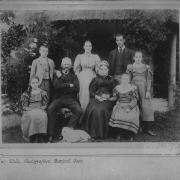







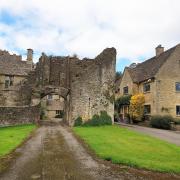



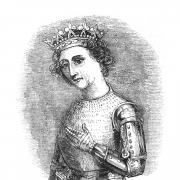

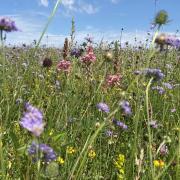
![Latenightpass with Gina Andrews [left] wins the Cross Country Chase at Cheltenham, December 15, 2023. Photo: Steve Davies/SDphotos.co.uk](/resources/images/128x89/1x/17621852.jpg)
![Latenightpass with Gina Andrews [left] wins the Cross Country Chase at Cheltenham, December 15, 2023. Photo: Steve Davies/SDphotos.co.uk](/resources/images/180x180/1x/17621852.jpg)



